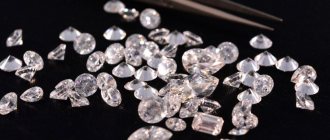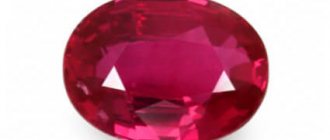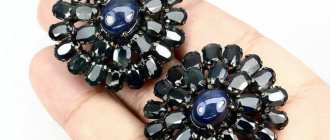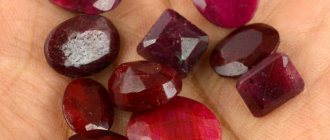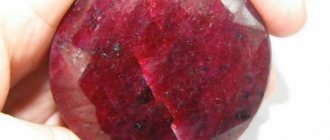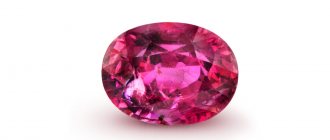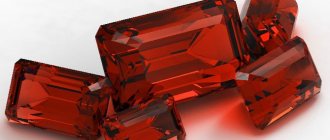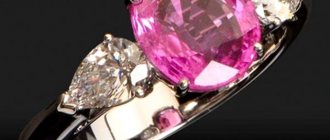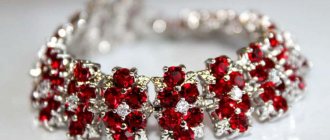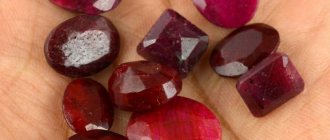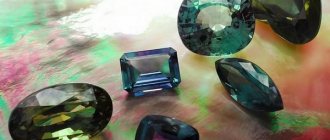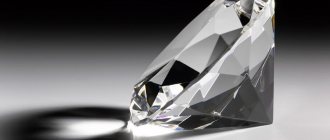Many people remember Soviet times and the jewelry that almost every woman wore then. They were all similar, as they differed little in design. But what was remarkable to many of them were the large stones, in particular rubies and alexandrites; few people knew then that they were synthetic. And all because there was no knowledge about the cost of stones. Alexandrite is one of the most expensive, and ruby is not much inferior to it. And really, how much is a ruby worth?
It is impossible to answer this question immediately. Like many gemstones, the cost of red corundum depends on many factors. Contrary to what most people think, it is not just the size of the stone.
Natural stone ruby
There are large rubies that are inexpensive. The cost will depend on factors such as color, origin, purity. Cutting and refining methods will also play an important role in this parameter.
The most famous rubies are mined in Burma. They are distinguished by a rich red color, with a slight blue tint. The color of such stones is called “pigeon blood”. Of course, such rubies are most accessible directly in Burma, but this does not mean that if you buy a stone there, it will definitely be of high quality.
Another interesting factor regarding ruby color is fluorescence. A property that is undesirable in diamonds is welcomed here. Since it is strongest in the red part of the spectrum, this property makes the ruby especially beautiful and shimmering. Not all rubies fluoresce, as different dyes, such as chromium and iron, can produce red colors and shades. Burmese rubies are colored with chrome and that is why they are so highly valued.
As with all gemstones of the highest grade, transparency is very important for them. It changes due to inclusions and microcracks. Such inclusions can be, for example, calcite or rutile.
Interestingly, their presence has different effects on the value of the ruby. The first reduces it, while the second increases it. Small needles of rutile in ruby are called "silk", and under some circumstances they can form an asterism effect. Such stones are star-shaped, they are cut into cabochons and are very expensive.
Of course, weight plays a primary role in determining the price of a ruby stone. Unlike other stones, high quality rubies are very rare and often weigh less than five carats after cutting. This causes the price to rise very quickly in proportion to the mass, much more than for sapphires and diamonds.
For example, the largest high-quality ruby that was sold at auction in 2014 weighed less than 30 carats, while the largest diamond weighed 545 carats. For reference: “Cullinan” from the collection of the British crown is not one of these today. But it is the largest colorless diamond, and at 530 carats, it is still much larger than rubies. Therefore, a high-quality 10-carat ruby will likely be more expensive than a similar-sized diamond.
A sensitive issue in the cost of rubies is the methods used to refine them. You can often hear the term “heated ruby” among jewelers. What does it mean? The fact is that by nature, most stones are endowed with inclusions, color inhomogeneities and are faded. When the stone is heated to high temperatures in a thermostat, most of the inclusions dissolve, and the chromium that is present there penetrates the structure of the stone and makes its color more rich and beautiful.
This method of processing is considered acceptable, but concealing it during sales is fraudulent. But there are other methods. For example, cracks in stones are often filled with composite resins or oil. Depending on the quality of the filling, the life of the mineral in this state may not last long. In addition, if there are too many cracks, then, in fact, it is no longer quite a ruby.
Surface-colored stones are not of very high quality. This is done as follows: the stone is heated in the presence of chromium, which penetrates the mineral to a shallow depth. This is due to the fact that chromium molecules are large. Such a fake can be revealed when you try to re-polish or re-cut the stone, but until then the layer will hold on. Unless, of course, the ruby is scratched, but this can only be done with the help of a harder mineral, for example, diamond.
Earrings with rubies
In order for the properties of a stone to be maximized, it must be properly cut. When cutting rubies, like other minerals, symmetry, shape, and quality of polishing are very important. If the stone has cracks or scratches, a pavilion, that is, the lower part is too long or short, and the stone does not seem very attractive to you and has “irregular shapes,” then such a cut is not of high quality. The most valued cut for rubies is the round cut, reminiscent of a diamond, but the marquise cut, or step cut, is valued lower.
No matter how high the quality of a ruby may be at first glance, a document can put an end to any debate regarding its price. It is not always possible to determine all parameters by eye and distinguish the synthetic origin of a mineral. The certificate will also help protect you from buying a stone that has been refined at the price of an untreated one.
How to determine the authenticity of a ruby
A synthetic analogue of a stone is not inferior to a natural one in beauty, attractiveness, and methods of use. And it costs much less. Imitation is simply deception of consumers. We'll tell you how to distinguish a real ruby from a fake.
Check authenticity at home
To check the authenticity of a ruby, it is not necessary to contact the assay office.
Using a magnifying glass
The easiest way to determine the originality of a ruby at home is to carefully examine the stone under a 10x magnification magnifying glass.
- The edges of the artificial stone look fuzzy and blurry.
- If the bubbles in the body of the stone are red, the ruby is real; transparent or absent - artificial.
- Microcracks on synthetics are smooth and shiny; on the gem - zigzag.
A glass counterfeit can be easily detected; distinguishing a natural ruby from an artificial one is more difficult.
With the help of light
Here's how to tell a real ruby from its synthetic counterpart using light.
- In direct sunlight, a natural ruby looks burgundy, while the color of the artificial stone fades.
- In ultraviolet rays, the gem will still glow red, but the synthetic one will begin to glow orange.
- When the stone is rotated in the light, purple tints may appear on the edges. This indicates the natural origin of the mineral. This is what samples of Burmese rubies called “pigeon blood” look like.
Under a magnifying glass, the effect of light on the stone will appear more clearly.
In liquids
In clean water, a reddish glow will emanate from a genuine ruby through the glass walls of the vessel.
Dipped in milk, the gem will turn the white liquid pink. This is an optical effect: the bright color of the ruby, breaking through the polydisperse compound, creates the illusion of coloring. Synthetics and glass are not capable of this.
For strength, weight and heat
Being a super-hard mineral, ruby can scratch glass and metal. Glass imitations are fragile, easily destroyed, and after exposure to them, chips and scratches remain.
The gem is noticeably heavier than a fake of similar weight.
It takes longer to heat up in your hands than the glass imitation.
How to distinguish a genuine ruby from cheaper similar stones
Cheaper gems that resemble red corundum in appearance are sold under the guise of ruby: garnet, tourmaline, spinel.
There are several ways to distinguish a ruby from a garnet.
- The garnet has a weaker shine and does not glow. Rotate the stone in the sun or under an electric lamp. The shine of a ruby is pronounced, similar to diamond, which cannot be said about a garnet.
- The color of garnet is darker than ruby.
- Garnet is magnetized, ruby is not. Place the mineral on the scale and apply the magnet. The weight has decreased - in front of you is a pomegranate.
Tourmaline can be easily identified by turning on an ultraviolet lamp. The red or pink hue of the mineral will change to orange. UV rays will not distort the color of a ruby. Like garnet, tourmaline does not glow.
Semi-precious red spinel is very similar to ruby. It is possible to distinguish between two gems only with the help of a refractometer and a dichroscope.
Ruby is characterized by dichroism - the optical effect of the appearance of a violet tint on red when the lighting changes. Other stones listed do not have this property.
The combination of dust from ruby rocks and glass is difficult to identify. The appearance is practically no different from the original. You have to resort to the services of a gemologist, who will find out how much of the natural component is in the sample.
Lastly (and perhaps first and foremost) is the price. Natural ruby is a gemstone of the first magnitude. The cost of a crystal weighing over a carat is equal to the cost of a diamond. A relatively low price is a sign of synthetics.
The Patiño Ruby is a 32.08 carat Mogok ruby in a ring from Chaumet
$6,736,750 ($209,998 per carat)
Advertising - Continued below
Christie's auction, Geneva, May 2012
A 32.08 carat cushion cut ruby sits on a pedestal of trapezoidal diamonds. The ring is accompanied by a report from the Swiss Gemological Institute (SSEF), confirming the Burmese origin of the stone and the absence of traces of heat treatment.
Also included is a letter which states: "The rich red color of the stone, also known as 'pigeon blood', is created by nature thanks to the unique combination of impurities typical of the finest examples of Mogok Valley rubies."
Imitation ruby
Composite stones are considered fake rubies. For example, a thin almandine plate is glued onto red glass. Examining the sample under a magnifying glass will reveal a bond line, or a change in gloss visible from a certain angle at the boundary between glass and garnet. Placing a sample in liquid will also help us find out if it is a fake. The doublet will give itself away as a straight line of connection.
You can distinguish a ruby from glass under a magnifying glass or microscope by gas bubbles and color funnels.
Rhinestones have a single light refraction, and the refractive indices do not correspond to the refraction of the gemstone. But glass can be confused with garnet and spinel based on this indicator.
You can distinguish a real stone from a fake mechanically: by running a file over the stone. A visible mark will remain on the glass or plastic. But what about ruby?
Cartier diamond ring with 29.62 carat Mogok ruby
$7,379,953 ($249,154 per carat)
Sotheby's auction, Hong Kong, April 2014
Advertising - Continued below
The stone has a rich color, which is an inherent quality of rubies from the famous Burmese valley. A worthy setting for it was a ring from Cartier, one of the most respected jewelry houses in the world. There are no traces of heat treatment on the ruby, and the unique combination of noble color and large size makes it an extremely valuable stone.
Synthetic ruby
An artificially produced specimen is called hydrothermal ruby. Synthetic gems are grown from a mixture of chromium, iron and low-quality non-jewelry corundum in special devices under special conditions. The results are complete analogues of natural stones.
An artificial ruby, like a natural one, leaves marks on the glass. The color of both is affected by the amount of chromium in the composition.
Synthetic ruby is perfection itself. Under ideal conditions, a defect-free sample grows. The same cannot be said about natural stones, which have been formed for centuries in an unfavorable (compared to a scientific laboratory) environment. Therefore, they are characterized by certain disadvantages.
Thanks to their correct, uniform structure, synthetic stones are easier to process, more convenient to cut, and flawless in appearance.
The Soviet ruby, a high-quality synthetic stone, is still of particular value.
8. 30.2 carat ruby set in diamond ring
$4,265,586 ($141,245 per carat)
Advertising - Continued below
Sotheby's auction, Geneva, May 2011
The 30.2 carat cushion cut ruby has exceptional color. Its splendor is complemented by two pear-shaped diamonds weighing 2 and 2.02 carats. The stones adorn this elegant platinum ring. The product is accompanied by a report from Gübelin confirming the origin of the stone and the presence of signs of heat treatment.
Refined rubies
To give a natural mineral greater transparency, enhance color, create or enhance optical effects, rubies are refined. For this use:
- high temperature treatment;
- surface diffusion;
- filling cracks with dyes or a colorless substance;
- foil linings;
- irradiation.
In most cases, rubies become more attractive after refining. Sometimes glass-like particles may appear or defects may expand.
Treated stones are natural, but are valued lower than untreated stones, closer to synthetic ones.
10. Burmese ruby weighing 12.46 carats in a ring with diamonds
$3,721,415 ($298,669 per carat)
Sotheby's auction, Geneva, May 2014
Advertising - Continued below
The ruby is cushion cut and rests between two large triangular diamonds. The ring comes with SSEF and Gübelin reports confirming the origin of the stone and the absence of traces of heat treatment. Also included is a letter describing the exceptional nature of this ruby.
How to grow stone
Synthetic rubies are obtained in several ways.
- The Vernel method is based on the melting of pre-mixed chromium and aluminum trioxide. Single crystals are obtained in the form of a cylinder up to 30 cm long and 2 cm in diameter.
- When using the Czochralski method, crystals are pulled upward from the starting material (seed).
- Zone smelting is the drawing of prepared raw materials along a heating element in a molybdenum container. Ruby in the form of plate-like crystals is formed when the alloy cools slowly.
- Columnar-shaped crystals are obtained by skull melting using high-frequency energy sources.
- In the hydrothermal method, fusible alumina and silica are mixed with chromium compounds, melted, and then placed in an autoclave.
All methods are labor-intensive and expensive.
How to grow a ruby crystal at home
It is impossible to obtain a synthetic ruby crystal without an autoclave, special chemicals and solid knowledge of chemistry and physics. But growing something similar to it is quite possible.
The easiest way is to buy a kit for growing crystals. Next do this:
- pour the powder into a suitable container, pour boiling water over it, stir thoroughly;
- after 2 hours, introduce the seed crystals, close the lid tightly;
- After a day, replace the lid with paper, wait 3-4 weeks.
After this, observe with your own eyes how “ruby” crystals appear.
You can grow an imitation from sugar. Prepare 3 tbsp. sugar, food coloring of a suitable color, 200 ml of water. The algorithm of actions is as follows.
- We dilute sugar with water and cook syrup.
- Add the dye, stir until dissolved, and cool slightly.
- We glue a crystal of granulated sugar to a thread, which, in turn, is tied to cardboard or a pencil to hold the structure at the desired height.
- Place the crystal in the sugar syrup in the center of the glass.
- Cover with paper and wait for crystallization.
In an extremely saturated solution, the sugar crystal will not dissolve, but will grow.
“Synthetic rubies” are grown from table salt in a similar way. You will need: 1 kg of salt, 400 ml of water, dye. We proceed like this:
- Fill a 0.5-liter glass container halfway with salt, add hot water, stir until completely dissolved;
- gradually add salt, stir until the particles no longer disappear from sight;
- add 5-7 packets of food coloring, stir;
- filter the solution into another container;
- we tie or glue a salt crystal to a thread, which we fasten to a pencil;
- lower the crystal into the solution;
- cover the jar with paper.
A red crystal resembling a gem will begin to form around the salt seed.
Such artificially grown rubies are used for their own needs and for sale, but not as jewelry, but as a souvenir.
The largest cabochon
When cutting a gem into a cabochon shape, the effect of asterism is most fully manifested. The so-called star gems are cabochons with an asterism effect. In them, the light is transformed into a 6- or 12-rayed star.
The largest cabochon ruby is the cherry-colored Reeves star ruby. At 138 carats, it is recognized as the largest and most beautiful star ruby.
Another ruby cabochon is the star De Long. A third less than the leader in weight, but also very large (100.32 carats).
Does an artificial mineral have healing and magical properties?
Natural ruby is valued not only for its beauty, but also for its magical properties, including attracting wealth and good luck in love, helping to wisely lead people. The healing effect of the mineral is also high.
Another thing is imitation ruby. There is no magical energy in glass or plastic, in crystals grown from salt or sugar.
The properties of a composite ruby, that is, an alloy of glass and a real ruby component, allow us to talk about its effect on the owner. However, this effect is less pronounced than the influence of a natural gem.
Artificial stone, that is, grown in laboratory conditions, has more modest healing and magical properties. Although disputes on this matter do not stop.
8.99 carat ruby diamond ring from Harry Winston
$3,935,105 ($437,720 per carat)
Christie's auction, Hong Kong, November 2013
The platinum and 18k gold ring features a stunning cushion-cut ruby surrounded by triangular diamonds. The ring is accompanied by a letter from the American Gemological Laboratory, according to which the stone has the rich, saturated color inherent in specimens mined in the Mogok deposit. Traditionally, this color of ruby is called “pigeon blood color.” A skillful cut highlights the richness of the color of this stone, creating a unique play of light inside the ruby.
